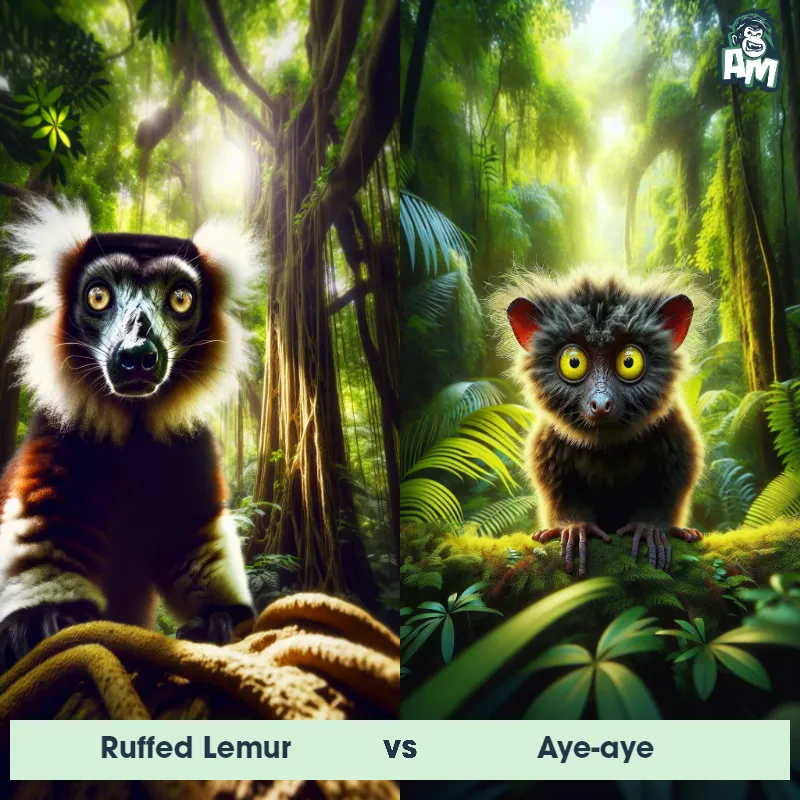The Aye-Aye
The Aye-Aye, also known as Daubentonia madagascariensis, is a unique and fascinating primate species native to the rainforests of Madagascar. This nocturnal animal has a distinctive appearance, with its large, round eyes and oversized ears.

| Aye-Aye | |
|---|---|
| Size | 14-17 inches (36-44 cm) |
| Weight | 2.2-4.4 pounds (1-2 kg) |
| Speed | 20 mph (32 km/h) |
| Key Strength | Sharp claws for defense and catching prey |
| Biggest Weakness | Fragile and lightweight body structure |
| Scientific Name | Daubentonia madagascariensis |
| Family | Daubentoniidae |
| Habitat | Forests |
| Geography | Madagascar |
| Diet | Insects, larvae, seeds, nectar, and fruit |
| Lifespan | 16 years - 23 years |

The Aye-Aye
The Aye-Aye, also known as Daubentonia madagascariensis, is a unique and fascinating primate species native to the rainforests of Madagascar. This nocturnal animal has a distinctive appearance, with its large, round eyes and oversized ears.
Fun Fact: One fun fact about the Aye-Aye is that it is believed to be one of the world's most unusual primates due to its unique feeding method, known as percussive foraging, where it taps its specialized finger up to eight times per second on trees to listen for hollow sounds indicating the presence of prey.
| Aye-Aye | |
|---|---|
| Size | 14-17 inches (36-44 cm) |
| Weight | 2.2-4.4 pounds (1-2 kg) |
| Speed | 20 mph (32 km/h) |
| Key Strength | Sharp claws for defense and catching prey |
| Biggest Weakness | Fragile and lightweight body structure |
| Scientific Name | Daubentonia madagascariensis |
| Family | Daubentoniidae |
| Habitat | Forests |
| Geography | Madagascar |
| Diet | Insects, larvae, seeds, nectar, and fruit |
| Lifespan | 16 years - 23 years |
Aye-Aye Matchups
We use AI to simulate matchups between the Aye-Aye and other animals. Our simulation considers size, strength, and natural predatory behaviors to determine the most likely outcome.
Aye-Aye: Diet, Predators, Aggression, and Defensive Behaviors
What do Aye-Ayes eat?
Aye-Ayes are primarily insectivores, feeding on insects like beetle larvae, cockroaches, and crickets. They also consume fruits, seeds, and the sap of certain trees. They use their long, thin middle finger to tap on wood and listen for hollow chambers where insects may be hiding.
Do Aye-Ayes have any predators?
Aye-Ayes have few natural predators due to their nocturnal behavior and elusive nature. However, they may be preyed upon by fossas, a type of carnivorous mammal found in Madagascar. Birds of prey and snakes are also potential predators of Aye-Ayes.
Are Aye-Ayes aggressive animals?
Aye-Ayes are generally solitary and shy creatures, and they do not exhibit aggressive behavior towards humans or other animals. They are more likely to flee than to confront a potential threat. However, they may defend themselves if they feel cornered or threatened.
Do Aye-Ayes fight with each other?
Aye-Ayes are solitary animals and do not interact much with other individuals except during mating season. While conflicts may arise between individuals over territory or mating opportunities, physical fights are rare. Aye-Ayes are more inclined to use vocalizations and body language to communicate their intentions.
How do Aye-Ayes defend themselves?
When threatened, Aye-Ayes may make loud vocalizations, puff up their fur, and show their teeth to deter predators or aggressors. They may also use their long, sharp claws for self-defense if necessary. Additionally, their nocturnal habits and arboreal lifestyle help them avoid many potential dangers.
What is the biggest weakness of Aye-Ayes in a fight?
Despite their sharp claws and strong jaws, Aye-Ayes are relatively small and lightweight compared to some of their potential predators. In a physical confrontation, their size and solitary nature may put them at a disadvantage against larger, more social animals with a group hunting strategy. Additionally, their specialized ecological niche and dependency on certain foods could make them vulnerable in an altered environment.
Fun Fact: Another interesting fact about the Aye-Aye is that it is solitary and nocturnal, spending its days asleep in nests made from leaves or in tree holes, and only emerging after dusk to begin its search for food.
Fun Fact: Did you know that the Aye-Aye has a highly developed sense of touch? This primate has large sensory hairs on its hands and feet, which it uses to feel vibrations and identify hidden prey inside trees, making it an exceptional hunter in its forest habitat.













